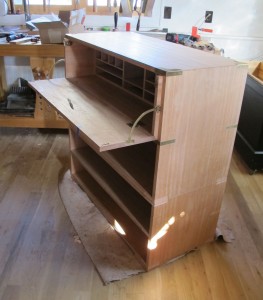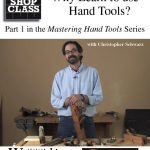We may receive a commission when you use our affiliate links. However, this does not impact our recommendations.
There is some good advice out there on how to drive brass screws when installing furniture hardware. To recap:
1. Use the right-size pilot holes. The bit should be the diameter of the un-threaded portion of the screw.
2. Use good screws. If your brass screws are soft, you should first cut the threads in the pilot hole using a steel screw. Better option: Buy better screws.
3. Use a little paraffin to lubricate the threads. No, it won’t hurt anything. Paraffin is mineral spirits that has had its melting point raised.
4. Use a screwdriver whose head fits the slot exactly. Repeat: exactly. Cheap, poorly ground and soft screwdrivers are a scourge on the craft.
With all the above tips in mind, the following video shows how I install screws for hardware and clock them so the slots are vertical. I think the trick that helps me the most is using a birdcage awl, which cuts the wood to make a cone at the beginning of the process. Lots of manufacturers make birdcage awls, which have a square – instead of a round – shank. Or you can make your own birdcage awl with a file (if you can’t find a vintage one).
The music in the video is from Underhill Rose, used with permission. This country soul group features Eleanor Underhill, the daughter of Roy Underhill and the illustrator for the new book “Make a Joint Stool from a Tree.” It’s good audio stuff. The track I used on this video is called “Learn.”
— Christopher Schwarz
Here are some supplies and tools we find essential in our everyday work around the shop. We may receive a commission from sales referred by our links; however, we have carefully selected these products for their usefulness and quality.










Maybe there should be a tiny try-square invented for setting your clocked screws to *exactly* 90degrees …
(And leave our platypii the hell alone)
🙂
Folks –
Don Dannenberg’s book on old wood boat restoration book notes how Chris Craft used to achieve vertically aligned screws on piano hinges used for hatches so that no over- or under-torquing occurred (both of which would non-optimal screw to wood connections). Specifically, they somehow acquired screws with built up heads and no pre-cut slots. After installing them to the right torque (don’t ask me how), they then backed them out 3-4 full turns. After cutting perfectly aligned vertical slots into the blank screw heads, they then retorqued them down.
Somehow I suspect the place one buys “better” brass screws is also the place one buys built up, blank brass screws!
Live and learn.
The video sure beats my method of driving the screws until the head breaks off, swearing, pulling out the screw body, swearing, then using epoxy to set the decorative piece in place and just a tiny dab of epoxy to hold the screw heads.
I know from experience a fat pilot hole and a hammer can work better than breaking screw heads off with a driver, but it can leave dings on fine brass trim.
Kevin
Today I’ll take some beautiful long, thick planks of wood and convert them into smaller pieces, shavings and sawdust, and if I’m very lucky – something useful and beautiful.
Excellent music tip, thanks for that. Is there anything that Underhill clan can’t do? Oh yeah, and the woodworking tip was good too
This was a vexing issue to me as well once upon a time. My solution that helped the most off all was a rather large range of tapered drills I purchased from Lee Valley. One of the “better idea” purchases I have made. I always use a stop collar, even if I’m doing just one screw. (Lesson from experience). It’s too easy to “overshoot” otherwise. The driver is a good point too. In my arsenal I don’t have some nice squared off dives though, but I have found the tips on my drill gun bits accomplish the same thing, so I use the manual handle with them and it works out great.
Lee Valley now carries mutton tallow. Might as well go whole-hog (sheep?) on the galoot thing.
I always run a steel screw in first, 3/4 of the way, then do the brass screw. Got tired of the soft brass breaking off with very little pressure. I will look into buying some of the screws mention in this article, though.
I use Akempucky for screws (mostly because I like the name, but also because it works so well). It’s beeswax with some oils added that make it somewhat softer and stickier and therefore easier to apply. And because it is oil and wax rather than soap, it isn’t hygroscopic and so it won’t lead to increased corrosion.
-Steve
Hey Chris,
Nowadays I chuck a Vix bit into the drill and get perfectly centered holes every time. I might have thought that not to be galoot enough for you, but then you used a cordless electric drill for your pilot hole.
As for the driver, I prefer to use a hollow ground screwdriver for soft screws. They tend to be a bit pricey, but they have perfectly parallel sides, and the slot is not tapered. The grip and fit is superior to a tapered driver.
My old man taught me to use a bar of soap for wood screw lube. I think that came from working in boatyards in the cold. There was always a softer side of the bar that rested on the sink, that was malleable even in the cold.
Tom
I made a birdcage awl from an old “pointy thing” that I found in my father-in-law’s tool box after he passed away(he was machinist) and it works fine. However, my go to methods are: 1) to use a self centering bit (“Vix bit”); or 2) a nail set to mark the hole. With its blunt tip, the nail set does not drift with the grain, and makes a depression large enough to hold the drill bit as it starts.
I like your Awl better then mine. Mine is round and only compresses the wood. While yours cuts the hole as you turn it. Very nice.
I also like lubricating the screw. Ivory soap has worked great for me. I rub it on with a tooth brush to leave a light coating the first half, but no gobs to later mar the finish.
I had not tried the chin press. But do like to get behind it for direct pressure on the last 1/4.
Chris, I was taught to clock the screws so that the slots ran the same way as the grain and that is usualy in line with the longest part of the hardware.
I use candle wax as a lubricant for screws and plane soles and this is traditional in England.
I use self centering pilot bits and have never broken one possibly because I use an egg beater hand drill that may be easier to hold vertical.
Veritas gimlets do a fine job of running the thread ready for the brass screw. Thats what gimlets are for.
A belt sander quickly grinds parallel tips onto drivers and cabinet drivers are easier to grind as the flats up near the handle allow a reference. Just trail the driver blade from the wheel end.
Keep up the great work. Regards, Bernard Naish
Hi Chris. Timely article for me. I’m driving #2 3/8″ brass screws for small hinges. Is a bird cage awl made for such small screws?
thanks.
Les
Chris –
Where does one find “better screws”?
Jonathan
=================================
Better screwdrivers: http://graceusaguntools.com/screwdrivers.htm
I bought a set many years ago for working on guns (I die a little inside each time I see boogered stock screws on an otherwise nice 1911), but they are perfect for woodworking. And if one in the set doesn’t match your screw size, grind or file it until it does. Made in the USA, too.
Or, roll your own by parallel grinding tips of screwdrivers you already own. It’s one of those little things that can save a ton of frustration.
Beeswax is what I was told by a guy driving screws into a wooden boat about 40 years ago